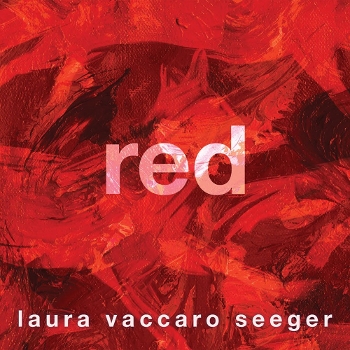Arguably one of the hardest things Caldecott committee members must do is put previous books by prolific illustrators out of their heads. While Red by Laura Vaccaro Seeger stands gloriously on its own, will the committee be able to put aside Green, which won a 2013 Caldecott Honor?
 Arguably one of the hardest things Caldecott committee members must do is put previous books by prolific illustrators out of their heads. While Red by Laura Vaccaro Seeger stands gloriously on its own, will the committee be able to put aside the experience of reading Green, which won a 2013 Caldecott Honor? When I first saw it, Green felt like something wholly new. The exploration of the differing shades of one color had never been done before with such artistry. Small swaths of color poking through die-cut holes was a brilliant way to explore the dynamic ways color can resonant differently in various settings. From the fluorescent lime-green limes with speckles of blue and yellow to give the fruit definition to the clever “never green” of the stop sign’s contrasting red, Seeger gave us such a distinctive exploration of the hue. Since both Red and 2018’s Blue follow the same format, using the same textural acrylic brushwork, do these works feel less fresh and original to our eyes? The committee members have to put previous work aside and reflect on whether or not Red’s artistry is distinguished and rises above other American picture books published in 2021.
Arguably one of the hardest things Caldecott committee members must do is put previous books by prolific illustrators out of their heads. While Red by Laura Vaccaro Seeger stands gloriously on its own, will the committee be able to put aside the experience of reading Green, which won a 2013 Caldecott Honor? When I first saw it, Green felt like something wholly new. The exploration of the differing shades of one color had never been done before with such artistry. Small swaths of color poking through die-cut holes was a brilliant way to explore the dynamic ways color can resonant differently in various settings. From the fluorescent lime-green limes with speckles of blue and yellow to give the fruit definition to the clever “never green” of the stop sign’s contrasting red, Seeger gave us such a distinctive exploration of the hue. Since both Red and 2018’s Blue follow the same format, using the same textural acrylic brushwork, do these works feel less fresh and original to our eyes? The committee members have to put previous work aside and reflect on whether or not Red’s artistry is distinguished and rises above other American picture books published in 2021.
Red takes us through a cohesive emotional journey, something that I felt was notably missing from the more conceptual Green. In the latest volume of the trilogy, a young red fox has wandered away from its pack. We see the pup in various settings and situations, such as the “dark red” of the forest at dusk, the “bright red” of brake lights, and the “blood red” of an injured paw. Each variation of red is a window into the pup’s internal mood. When the fox realizes it has strayed from the pack, the “lost red” fox is alone in a landscape of muddy greens and tawny browns with a rectangular die-cut boxing in and isolating the pup. The page-turn then reveals how vulnerable the fox is on a dark street as a car’s headlights illuminate the same image from the previous page. The narrative builds to the crisis point when the fox is caged and the page explodes in pulsating red cross-hatched lines of the prison bars. The fox’s red hair and bright pink mouth make up an image of “rage red” that is not soon forgotten. And when the pup finally returns to its pack, reunited with what we assume is its mother, the “just red” resolution is immensely satisfying in the russet autumn landscape.
As in Seeger’s other books, the heavy acrylic brushwork begs to be touched. The reproduction of her art is of such high quality that the texture of the canvas is visible on every page. We can see where the paint is thickly applied, giving the art a visceral quality. The “mud red” spread is a perfect example of this. The paint is as thick and clumpy as mud, broken up only by the lighter streaks of rain, as if they are simultaneously muddying up and washing away the paint on the canvas. And the die-cut holes are another textural element. Often these shaped holes melt into the page, only to be located via tactile exploration (which Seeger noted in her wonderful blog entry about the creation of Red).
The die-cut holes were such a unique feature of Green, but in Red it feels like Seeger has mastered their ability to interlock the narrative. The “rust red” nails, created through die-cut holes, become the background where the fox stares at a “blood red” paw caused by said nails. The die-cut holes are life-threatening blood droplets on one page, but on the page-turn they are life-giving “apple red” fruit. An apple-shaped die-cut hole hints that the fox is getting closer to civilization, and the page-turn transforms the apple into a human-built “brick red” wall, halting the journey of the fox.
During a period when many of us readers have relied on e-books, the experience of reading the e-book version of this book does not compare with reading the physical copy. The die-cut holes vanish in the online version, and many of the details in the illustrations disappear on the small screen. I know it has been difficult for publishing companies to get physical copies to readers for review, but final copies of the book are essential to the work of the Caldecott committee, more so than almost any other award. The bound book is a structural object that offers children a tactile experience that can’t be replicated online. Red needs to be experienced in hand, arguably more than any of the other contenders listed on this blog, due the visual surprise and tactile nature of the die-cut holes.
In the author’s note for Red, Seeger describes her artistic journey with the books in this trilogy and notes how the characters in the three books connect. Personally, I love when creators bring back characters and refer to their earlier work for the eagle-eyed close reader, but this work can stand on its own. The fox is the center of the story, and the girl, who could be the preschooler we meet at the end of Green, is only a supporting character. Children will readily identify with this fox lost in the woods during a time when we all have felt a bit lost. The fox’s rage and frustration are our own. Red stands on its own, a heart-rending and heart-warming reflection of the time we find ourselves in.
So here’s hoping this year’s committee can come to Red with fresh eyes. The manual clearly states that committee members are not to consider an artist’s body of work; they are only to compare it to other books published that year. Committees have honored the same illustrator multiple times. For example, two of Mo Willems's Knuffle Bunny books won honors, and two books by Jon Klassen won the Caldecott Award and an honor the same year Seeger won honors for Green. Committee members can and should put aside an illustrator's past work to look at each book fresh.
Will Red shine bright this year and possibly bring Seeger Caldecott gold?
[Read the Horn Book Magazine review of Red.]

ALREADY A SUBSCRIBER? LOG IN
We are currently offering this content for free. Sign up now to activate your personal profile, where you can save articles for future viewing.








Add Comment :-
Be the first reader to comment.
Comment Policy:
Comment should not be empty !!!